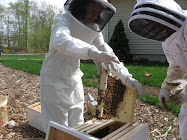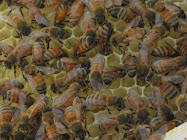Over the past two weeks, after hearing an On Point segment on WBUR - regarding the safety of plastics and our food called Our Toxic Environment, I started researching the subject and chatting with friends regarding our health and our environment. Another segment on On Point that is interesting is The-Body-Chemistry-of-America. Here are some of the things I've discovered:
Do not use plastic with a #7 in the recycling triangle. This type of plastic seeps chemicals (Bisphenol A or BPA and phthalates) into the liquid or food it contains. About Bisphenol A, Parenting Magazine (sept. 2007) commented "A chemical in some plastics called bisphenol A (BPA) — which has been linked with cancer, impaired immune function, hyperactivity, and other problems — can leach into a bottle's contents."There's no need to be frightened, but you should try to reduce your baby's exposure to this chemical," says pediatrician Harvey Karp, M.D., a board member of Healthy Child Healthy World, a non-profit group that raises awareness about environmental toxins." In rats phthalates have caused hormonal problems, non-cancerous tumors, genetal diformities. In humans, asthma, allergies, low sperm counts in men have been "statistically linked" to phthalates. An article in USA Today by Elizabeth Weise and Liz Szabo said "Europe took it (phthalates) out of toys years ago," Borrone says. "Why are we so behind?" Her home state is catching up with her. This month, California Gov. Arnold Schwarzenegger signed into law the country's first ban on the use of phthalates in toys and other children's products. Under the law, any product made for young children that contains more than one-tenth of 1% of phthalates cannot be sold or distributed in California beginning in 2009."
You may use plastic with a #5 in the recycling triangle, but do not wash it in the dishwasher or heat it in the microwave -- as the heat allows the plastic to release the chemicals into your food / liquid. And as the plastic gets older or scratched it must be recycled b/c the wear and scratches allow for the chemicals to seep.
I've decided to reduce my use of plastic and get rid of my tupperware and plastic sippy cups / water bottles.
Here are some good resources if you're interested.
For lunches: Wrap your sandwiches in good ole' fashioned wax paper like your mom used to (my mom did anyway).
For sippy cups / water bottles: Kleancanteen has great metal options. The plastic that is on the cup is non seeping.
Here are some good resources if you're interested.
For lunches: Wrap your sandwiches in good ole' fashioned wax paper like your mom used to (my mom did anyway).
For sippy cups / water bottles: Kleancanteen has great metal options. The plastic that is on the cup is non seeping.
For sippy cup with handles: Thermos has a metal sippy cup with handles for younger ones.
For tupperware alternatives: Williams-Sonoma has great glass food storage containers, although they are a little pricey -- but they are airtight with a metal top and can go in the freezer. Very cool! Also, Crate-and-Barrel also offers cute glass storage containers with glass tops.
Other environmental accomplishments:
I'm committed to drinking filtered water in a water bottle (not plastic of course). After doing some reading, my sister-in-law reported to me that recycling plastics is the most toxic form of recycling. Better to recycle, but better still not to create the piles of plastic that needs to be recycled. I'm just trying to do my part.
I'm trying not to use plastic wrap or ziplock baggies. I'm using my new glass storage containers instead. We'll see how it goes.
My sister-in-law saved 40% on her electric bill for the past two months. Want to know how? Air drying her clothes (indoors) rather than in her electric dryer. Wow! As an experiment, for the past week I've air dried my clothes. It was not that difficult, and I felt so good about accomplishment that it made laundry a lot more fun.
Well, that's a lot of information for you to munch on. Enjoy.






























No comments:
Post a Comment